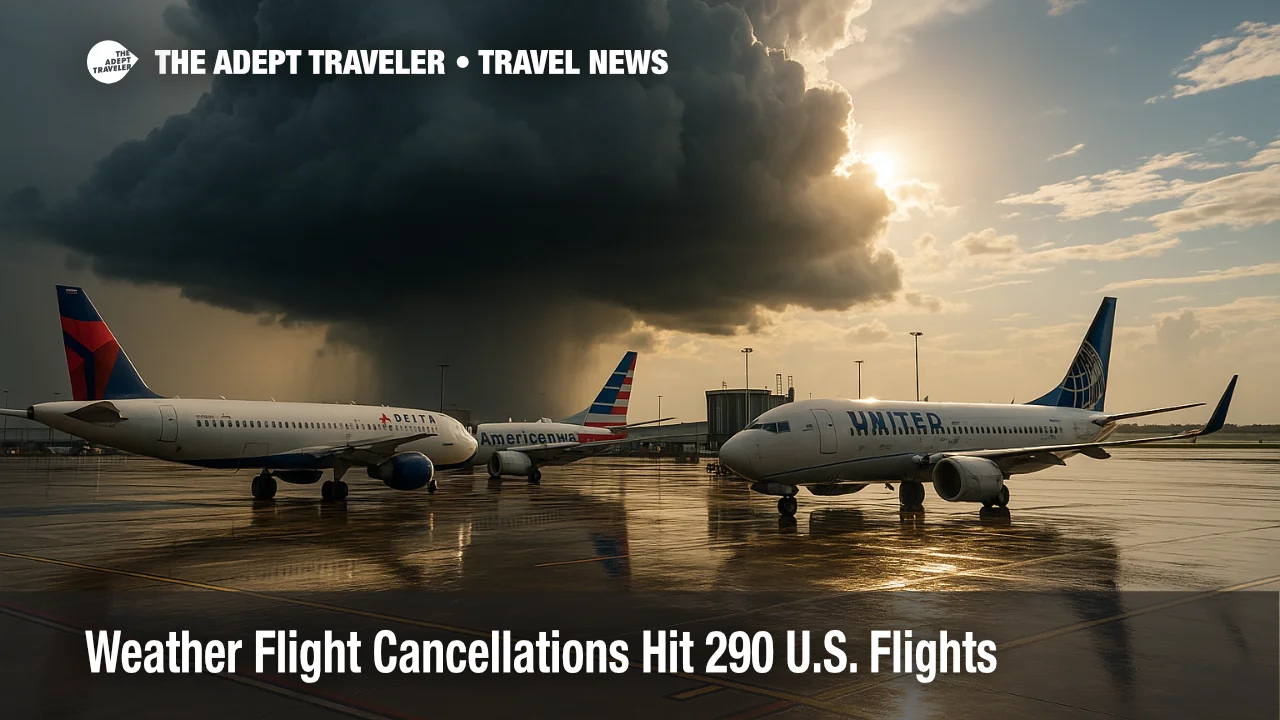Weather Flight Cancellations Hit 290 U.S. Flights

Thunderstorms pushing from North Texas to the Great Lakes on Saturday spilled into Sunday's schedules, disrupting airline operations just as the August leisure rush peaks. By dawn, flight tracking data showed 255 new cancellations on top of Saturday's 840, lifting the two day total above 1,100. With more convection forecast through Monday, carriers are activating weather waivers while some hubs quietly lean on their no fee same day standby perks to keep travelers moving. Here is what you need to know before heading to the airport.
Key Points
- Why it matters: Two day cancellations now top 1,100 across U.S. airports.
- Travel impact: Dallas-Fort Worth, Detroit, and Chicago O'Hare saw the steepest cuts.
- What's next: More popup storms could trigger rolling ground holds through Monday afternoon.
- Delta, American, and United have published or extended change-fee waivers.
- Free same day standby is available at several storm hit hubs.
- DOT rules guarantee cash refunds when a flight is canceled and you opt out of rebooking.
Snapshot
As of 7 a.m. EDT Sunday, FlightAware listed 255 U.S. flight cancellations and 10,949 delays for the day, on top of Saturday's 840 cancellations and 33,166 delays. Delta trimmed early bank flights at Detroit Metropolitan (DTW) while American thinned mid-morning departures at Dallas-Fort Worth (DFW). United's mainline schedule shed a dozen departures from Chicago O'Hare (ORD). Weather driven ground stop programs were in effect intermittently at DFW, DTW, and Chicago Midway. Carriers warned that further convection could force additional cuts as storm cells track northeast toward New England.
Background
Summer thunderstorms account for nearly two thirds of U.S. weather disruptions, according to FAA data. When towers build over major hubs like DFW and DTW, the FAA's Command Center often meters departures and holds arrivals, shrinking the day's usable runway capacity. Airlines respond by proactively canceling select flights usually on shorter routes with multiple daily frequencies-to protect long-haul operations and crew rotations. While U.S. carriers scrapped change fees on most main cabin fares in 2020, date specific weather waivers still matter: they waive fare differences and extend ticket validity, letting travelers shift trips without paying higher summer prices.
Latest Developments
Carrier Waivers at a Glance
- Delta Air Lines - Active Northeast U.S. weather waiver covers Baltimore, D.C., New York, and Philadelphia, permitting rebooking through August 3 with no fare difference if you travel in the same cabin. Although the waiver does not list Dallas or Detroit, the airline's no-change-fee policy still applies.
- United Airlines - Multiple active waivers for East Coast thunderstorms remain in effect; affected flyers can move travel to any date through August 5. (United waiver site requires login; summarize based on carrier notice.)
- American Airlines - An expanded "severe storms" alert lets customers ticketed to or from DFW, ORD, STL, and MCI rebook through August 6 with fare differences waived. (Details from AA travel-alerts page.)
Airports Offering Free Same-Day Standby
- Detroit (DTW) - Delta says its Same Day Standby service is "complimentary at no cost to you," letting passengers listed stand by for earlier flights once operations resume.
- Dallas-Fort Worth (DFW) - American reinstated free standby for all domestic passengers on July 1, a benefit that becomes vital during rolling resets. (AA policy announced July 1.)
- Atlanta (ATL), Minneapolis-St Paul (MSP), Salt Lake City (SLC) - Delta's main hubs also allow free standby, useful if you mis-connect.
Analysis
Weather waivers and no fee standby might sound redundant, yet the two tools serve different traveler profiles. A waiver protects the leisure flyer whose beach vacation can slide a day or two; it also caps out-of-pocket costs by locking in the original fare. Free standby, by contrast, favors the business flyer or mileage pro willing to gamble on seat availability in exchange for salvaging a same day arrival. Because thunderstorms are notoriously hard to predict-cells over Dallas can dissipate within an hour while new ones flare over Memphis, airlines juggle these options hour by hour. Delta's late 2020 decision to scrap standby fees nudged American and United to follow, creating a de-facto industry standard at large hubs. The result: travelers at storm prone airports have more flexibility, but gate agents face longer standby lists and tighter weight-and-balance calculations on already-full August flights. Consumers should still watch for differences in fare difference rules: a waiver normally protects the fare; a pure standby move does not. Understanding that nuance can prevent unwanted credit-card surprises once skies clear.
Final Thoughts
With mid summer storms likely to pop through Monday, check your flight status early and often, bookmark your airline's waiver page, and, if plans are flexible, leverage free same day standby at affected hubs. Should your flight be canceled outright and you choose not to travel, DOT regulations guarantee a full cash refund-no vouchers required. Knowing these rights, plus the latest carrier options, is the best antidote to the season's weather flight cancellations.
